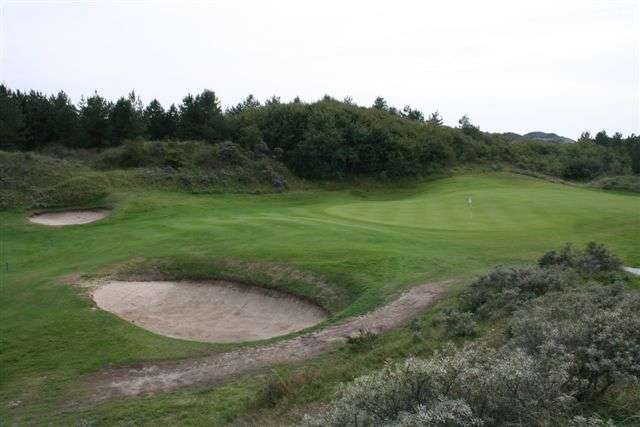The par three 2nd sets a high standard for the one shotters that follow, and they meet the challenge
The approach to the par four 11th must carry these bold bunkers to reach the green, which is hidden behind the fronting dune
The 16th is a prime example of the quality sites Colt chose for his greens at Le Touquet
Looking back down the dramatic par five 17th, which rises steeply near the green
Course name: Le Touquet (La Mer)
Location: Le Touquet Paris-Plage, Normandy, France
Four Word Course Review: Greensites the major attraction
Just 45 miles from Rye, where he started his design career, Harry Colt designed La Mer (The Sea) course on the other side of the English Channel at Le Touquet in 1931 to complement Horace Hutchinson's 1907 course, La Foret (The Forest) in the French resort town.
It's remarkable that the course sits so close to the likes of Rye, Littlestone, Deal and Sandwich, with thick saltscrub vegetation lining the playing corridors completely unlike the English seaside courses, though the terrain is very similar. Just a few miles north, a pine forest abuts the seaside, again completely at odds with the vegetation across the Channel.
As with everything else I have seen by Colt, the par threes are an obvious thing to note first up. Four very good one shotters, and all different from one another. The long 2nd threads between two dunes, the 7th plays slightly uphill to an angled dune, bunkered at the front, the 10th is a mid iron from one dune to another over a valley much like the 5th at Rye and the final short hole, the 15th, is a more subtle hole like Colt's 8th up the coast at Royal Zoute, but calling here for precise play late in the round.
The par fives are relentlessly competant without blowing you away - interesting doglegs and well-defended greens for the most part, with the possible exception the 17th, which stands above the others in the memory by climbing spectacularly over the last 150 yards to a blind green.
Of the par fours, the most notable are the 11th, playing from an elevated tee to a green obscured behind a well-bunkered cross dune, 12th with its bunkerless green slipping off a dune and short 14th, flanked left by a creek before bending to the same side with the green fronted by cross bunkers.
Not surprisingly, many of these better holes named above occupy the most undulating land closest to the seaside, while the likes of the 4th, 5th, 6th and 8th are furthest inland where the terrain flattens.
Sections of the course were lost during World War 2, with an imposing machine gun placement next to the 13th offering a reminder of that time, though the club says Colt's original layout was reinstated during the 1990s.
At times the course becomes too narrow for the style of golf and the impenitrable vegetation, but largely this is very good coastal golf, particularly the final 10 holes.
Tuesday, September 28, 2010
Subscribe to:
Post Comments (Atom)




No comments:
Post a Comment